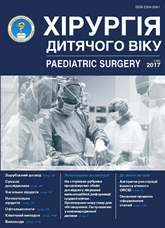Features of infected wounds treatment in children
DOI:
https://doi.org/10.15574/PS.2017.55.62Keywords:
wound, laser flowmetry, tissue viability, childrenAbstract
Objective: to study the treatment outcomes of infected wounds by investigation the viability of wound edges during the surgical treatment.Materials and methods. We observed 40 children with infected wounds that were treated at the Pediatric Surgery Department of Zaporizhia Regional Children’s Clinical Hospital during the period 2013-2016. All children underwent the initial surgical debridement, which included the excision of devitalized tissues followed by suturing. In the main group, in addition to subjective (visual) methods, the objective ones for determining the vitalized wound tissues were used. Diagnosis of the tissue perfusion was carried out by the 1-centimeter-spaced in depth and at length study of the microcirculation around the perimeter of wound edges, using the laser doppler flowmetry.
Results and discussion. The initial debridement without excision of the estimated skin area of injuries with the reduced blood flow was performed in patients of the main group in 27.5% of cases, and in the control group – in 35% of cases. The initial debridement with the removal of devitalized areas was provided in 17.5% and 20% of cases respectively. The satisfactory wound healing was achieved significantly more often after the excision of assessed devitalized areas in the main group than in the control group (p<0.001). The development of necrotic edges during the postoperative period in children, who did not underwent the avivement, was observed in 2.5% of main group cases and in the 17.5% of control group cases (p<0.05). In the comparison group also noted the inviability of soft tissue areas in 7.5% of cases, where the partial resection of wound edges was performed. Those patients also experienced festering wounds, which required local therapy and wound drainage.
Conclusions. 1. The investigation of microcirculation parametres improves by 44.4% the outcomes of the surgical initial debridement of wounds. 2. The using of the laser doppler flowmetry in the determation of the microcirculatory bloodstream at the first day of admission to hospital allows to select the extent of surgical debridement and contributes to the reduction of hospital stay.
References
Bezrukov SG, Grigorieva TS. (2012). LDF-monitoring results in patients after surgical treatment of atheroma person. Taurida health biologichseky Gazette. 4(60): 43-46.
Vinnik YS, Markelov NM, Shishatskaya EI Kuznetsov MN. (2015). On the selection of wound coverages in the treatment of purulent wounds. Fundamental research. 1: 1061-1064.
Savelyev VS (2008). Clinical Surgery. National leadership in 3 volumes. M.: GEOTAR Media. 1: 858. PMCid:PMC3705487
Mokhova OS, Ostroushko AP. (2016). On the issue of regional treatment of purulent wounds. Medical Sciences. 5: 72-74.
Mokhova OS. (2013). Modern methods of treatment of purulent wounds. Journal of anatomy and histopathology. 2(4): 15-21.
Parshikova SA, Parshikov VV, Potekhina YP. (2012). Prediction of postoperative complications in the treatment of extensive wounds bitten face in children using infrared thermography. Journal of Experimental and Clinical Surgery. 5; 2: 340- 346.
Baser YM. (2012). Surgical treatment of wounds: current approaches. Surgery Eastern Europe. 3: 286-287.
Walker M, Metcalf D, Parsons D. (2015). A real-life clinical evaluation of a next-generation antimicrobial dressing on acute and chronic wounds. J Wound Care. 24: 11-22. https://doi.org/10.12968/jowc.2015.24.1.11; PMid:25543819
You HJ, Han SK. (2014). Cell therapy for wound healing. J Korean Med Sci. 29: 311-319. https://doi.org/10.3346/jkms.2014.29.3.311; PMid:24616577 PMCid:PMC3945123
Downloads
Issue
Section
License
The policy of the Journal “PAEDIATRIC SURGERY. UKRAINE” is compatible with the vast majority of funders' of open access and self-archiving policies. The journal provides immediate open access route being convinced that everyone – not only scientists - can benefit from research results, and publishes articles exclusively under open access distribution, with a Creative Commons Attribution-Noncommercial 4.0 international license(СС BY-NC).
Authors transfer the copyright to the Journal “PAEDIATRIC SURGERY.UKRAINE” when the manuscript is accepted for publication. Authors declare that this manuscript has not been published nor is under simultaneous consideration for publication elsewhere. After publication, the articles become freely available on-line to the public.
Readers have the right to use, distribute, and reproduce articles in any medium, provided the articles and the journal are properly cited.
The use of published materials for commercial purposes is strongly prohibited.

